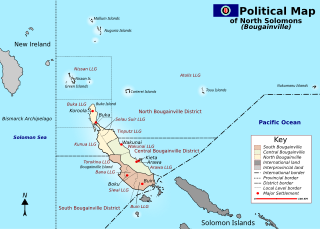 |
|---|
| This article is part of a series on the politics and government of Bougainville |
Presidential elections were held in Bougainville (an autonomous region of Papua New Guinea) from November 30 to December 18, 2008. [1] Voters elected the new President of the Autonomous Region of Bougainville, following the death of President Joseph Kabui while in office, on June 7.

Bougainville, officially the Autonomous Region of Bougainville and previously known as North Solomons, is an autonomous region in Papua New Guinea. The largest island is Bougainville Island. The region also includes Buka Island and assorted outlying nearby islands including the Carterets. The interim capital is Buka, though it is expected that Arawa will become the permanent capital in the future. The population of the region is 249,358.

Papua New Guinea, officially the Independent State of Papua New Guinea, is an Oceanian country that occupies the eastern half of the island of New Guinea and its offshore islands in Melanesia, a region of the southwestern Pacific Ocean north of Australia. Its capital, located along its southeastern coast, is Port Moresby. The western half of New Guinea forms the Indonesian provinces of Papua and West Papua.

The President of the Autonomous Region of Bougainville governs the island, which is an autonomous entity within Papua New Guinea.
The potential resumption of controversial mining activities, which were at the root of Bougainville's civil war in the 1990s, was reportedly a key issue in this election. [2]

The Bougainville Civil War, also known as the Bougainville conflict, was a multi-layered armed conflict fought from 1988 to 1998 in the North Solomons Province of Papua New Guinea (PNG) between PNG and the secessionist forces of the Bougainville Revolutionary Army (BRA), and between the BRA and other armed groups on Bougainville. The conflict was described by John Momis as the largest conflict in Oceania since the end of World War II in 1945, with an estimated 15,000 to 20,000 Bougainvilleans dead.
There were twelve candidates at the by-election: Nick Peniai, Edward Okuwau, Gerard Sinato, Sam Kauona, Clarence Cozxiune, James Tanis, Ruben Siara, Sam Akoitai, Sylvester Niu, Joel Banam, Raymond Hakena and Patrick Leslie. [3] The two favourites had been considered to be Papua New Guinea's former mining minister Akoitai and former rebel leader Kauona. [4] In total, 14 candidates stood in the election. [5] Sinato represented Kabui's Bougainville People's Congress, while Hakena represented the New Bougainville Party. [6] [7]
James Tanis is a politician in Papua New Guinea who was elected President of the Autonomous Region of Bougainville in 2008 following the death of Joseph Kabui while in office, serving the remainder of the term from 2009 to 2010. He was previously the Vice President of the Bougainville People's Congress.
Sam Akoitai, born 5 May 1961 in Bougainville, is a Papua New Guinean politician, a member of the United Resources Party.
The Bougainville People's Congress was a pro-independence organisation and later political party in the Autonomous Region of Bougainville, Papua New Guinea.
The election was won by James Tanis, a former Bougainville Revolutionary Army separatist and the third-place candidate in the 2005 election, with 11,112 votes. Akoitai finished second with 9,217 votes. [8] Tanis was sworn in on 6 January 2009. [9]
The Bougainville Revolutionary Army (BRA) was formed in 1988 by Bougainvilleans seeking independence from Papua New Guinea (PNG). The leader of the BRA was Francis Ona who led the BRA against the Papua New Guinea Defence Force during the violent 10 year conflict. Not all the BRA were agreeable to the Peace Treaty and boycotted it and have been holding and living in an official no-go zone, protected by members of the Meekamui Defence Force whose current Commander is Moses Pepino.